Assessment of Properties of Structural Lightweight Concrete with Sintered Fly Ash Aggregate in Terms of Its Suitability for Use in Prestressed Members
Abstract
1. Introduction
2. Materials and Methods
2.1. Materials
2.2. Methods
2.2.1. Tests of Hardened Concretes Specified on Standard Specimens
2.2.2. Tests of Hardened Concretes Specified on Big-Scale Beams
3. Results
3.1. Results and Discussion
Consistency and Density of Fresh Concrete
3.2. Density of Hardened Concrete
3.3. Compressive Strength
3.4. Tensile Splitting Strength
3.5. Modulus of Elasticity
3.6. Shrinkage
3.7. Creep
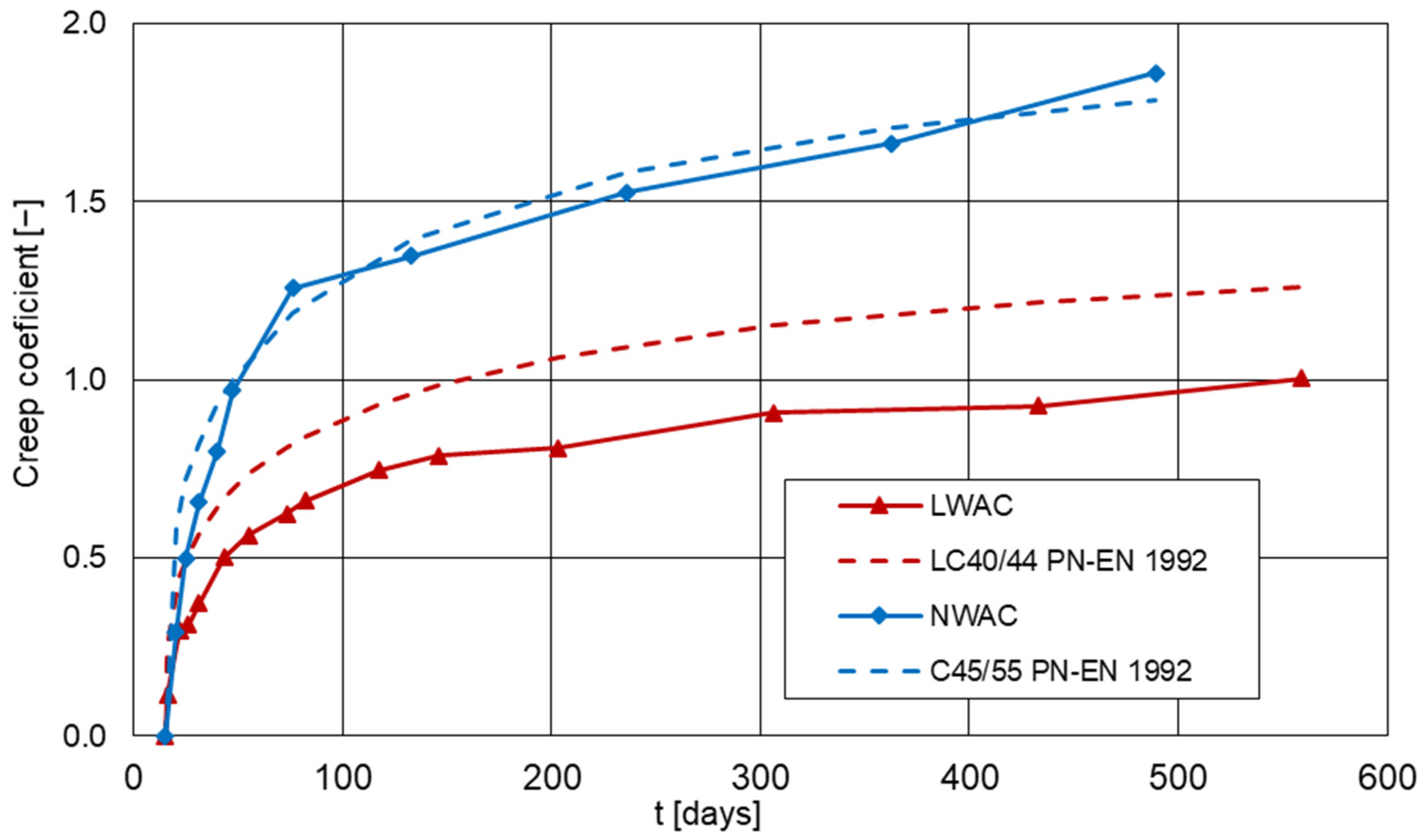
4. Conclusions
- The average density of the tested lightweight concrete was 20% lower than that of normal-weight concrete, while its average compressive strength at 28 days was only 10% lower than that of normal-weight concrete.
- As assumed, after 28 days of curing, both concretes showed a similar mean compressive strength, determined on cube specimens, 46.5 MPa and 50.7 MPa for LWAC and NWAC, respectively.
- The obtained compressive strength of tested LWAC confirms that achievement of higher strength of lightweight concrete with Certyd aggregate is possible.
- The shape of the stress–strain relationship in the uniaxial compression for the tested lightweight concrete corresponds to the graphs in the tests discussed in the literature. On the other hand, the tested normal-weight concrete, due to the use of dolomite crushed aggregate, showed a slightly different nature of this relationship compared to typical structural NWAC. In the case of normal-weight concrete, up to the level of effort of about 65%, the strain-stress curve was linear, while for lightweight concrete, the corresponding level of effort was 80%.
- As in the case of the compressive strength, the tensile strength value of lightweight concrete at 28 days of curing was 11% lower than that of normal-weight concrete. However, for both concretes, the tensile strength values were slightly lower than those provided in Eurocode EN-1992-1-1 [3]. Nevertheless, these differences are insignificant and prove a good standard estimation.
- The failure of specimens of both concrete types, tested for compressive strength as well as for tensile strength, occurred via the aggregate grains. Such a type of failure indicates that the contact zone in both tested concretes was not the weakest element of their structure and had a positive effect on the homogeneity of these composites.
- As expected, the modulus of elasticity of the tested lightweight concrete was lower (by 34%) than that of normal concrete. It should also be noted that for both LWAC and NWAC, the standard estimations differ only slightly from the obtained test values, which confirms the reliability of the estimations according to Eurocode EN-1992-1-1 [3].
- The increase in compressive strength, tensile strength, and modulus of elasticity between 28 and 90 days of curing is much greater for normal-weight concrete than for lightweight concrete. A smaller increase in the mechanical characteristics of LWAC is caused by the limiting effect of the porous aggregate, which is weaker than the cement matrix.
- The shrinkage of lightweight concrete in the initial period of its curing (up to about 100 days) revealed a much less dynamic development in comparison to normal-weight concrete. The reason for this different rheological behavior of LWAC was probably a significant amount of water accumulated in the porous aggregate. Later, the shrinkage of lightweight concrete increased linearly, but by the end of the tests (i.e., up to 559 days), it did not reach stabilization, and its value was still as much as 36% lower than for normal-weight concrete. Such behavior of tested LWAC turned out to be different from that reported in the available thematic literature, indicating that in the vast majority of cases, the shrinkage of lightweight concrete after about a year reaches the value of shrinkage of NWAC of comparable strength. Due to the lack of shrinkage stabilization for the tested LWAC, it can be expected that it will eventually reach higher values compared to NWAC. However, confirmation of the above would require a much longer observation period.
- The course of shrinkage of the tested normal-weight concrete turned out to be consistent with the estimations of Eurocode EN-1992-1-1 [3], and the determined final values were only slightly higher than those calculated according to the standard. However, the tested final values of shrinkage deformations for lightweight concrete were 38% lower than estimated according to Eurocode EN-1992-1-1 [3], and its course over time differed mainly in the initial period (up to about 100 days).
- The final creep deformations of the tested lightweight concrete were more than two times lower than those of the corresponding normal-weight concrete despite significantly lower final strength.
- The course and values of the lightweight concrete creep coefficient calculated according to EN-1992-1-1 [3] are significantly overestimated in relation to the obtained results of LWAC tests. On the other hand, for normal-weight concrete, the test results practically coincided with the estimated values according to the standard.
- Discrepancies in values of both rheological properties, shrinkage and creep, determined in tests and estimated according to Eurocode EN-1992-1-1 [3] for lightweight concrete may result from the lack or insufficient consideration of the influence of the type of aggregate and the internal curing of LWAC with water accommodated in the aggregate in standard estimations.
Author Contributions
Funding
Institutional Review Board Statement
Informed Consent Statement
Data Availability Statement
Acknowledgments
Conflicts of Interest
References
- Chandra, S.; Berntsson, L. Lightweight Aggregate Concrete; Noyes Publications: New York, NY, USA, 2003. [Google Scholar]
- Clarke, D.J.L. (Ed.) Structural Lightweight Aggregate Concrete; CRC Press: London, UK, 2014. [Google Scholar]
- EN 1992 Eurocode 2; Design of Concrete Structures—Part 1-1: General Rules and Rules for Buildings. European Committee for Standardization: Brussels, Belgium, 2013.
- Domagała, L. Structural Lightweight Aggregate Concrete/Konstrukcyjne Lekkie Betony Kruszywowe; CUT Publishing House: Cracow, Poland, 2014. (In Polish) [Google Scholar]
- Neville, A.M. Properties of Concrete, 5th ed.; Pearson Education Limited: London, UK, 2012. [Google Scholar]
- Domagała, L. A Study on the Influence of Concrete Type and Strength on the Relationship between Initial and Stabilized Secant Moduli of Elasticity. Solid State Phenom. 2017, 258, 566–569. [Google Scholar] [CrossRef]
- American Concrete Institute. ACI 213 R-03, Guide for Structural Lightweight Aggregate Concrete; American Concrete Institute: Farmington Hills, MI, USA, 2014. [Google Scholar]
- Ishikawa, Y.; Tomasawa, F.; Hayakawa, M.; Sasahara, A.; Yasuda, M. Fundamental Characteristics of Concrete Using High Strength Artificial LWA made of fly ash. In Proceedings of the 2nd International Symposium on Structural Lightweight Aggregate Concrete, Kristiansand, Norway, 18–22 June 2000; Volume 6, pp. 593–602. [Google Scholar]
- Uijl, J.; Stroband, J.; Walraven, J. Spitting Behaviour of Lightweight concrete. In Proceedings of the International Symposium on Structural Lightweight Aggregate Concrete, Sandefjord, Norway, 20–24 June 1995; pp. 154–163. [Google Scholar]
- Tian, Y.; Shi, S.; Jia, K.; Hu, S. Mechanical and dynamic properties of high strength concrete modified with lightweight aggregates presaturated polymer emulsion. Constr. Build. Mater. 2015, 93, 1151–1156. [Google Scholar] [CrossRef]
- PN-91/B-06263; Beton Lekki Kruszywowy. Polski Komitet Normalizacyjny: Warsaw, Poland, 1991.
- Yoon, J.Y.; Kim, J.H. Mechanical properties of preplaced lightweight aggregates concrete. Constr. Build. Mater. 2019, 216, 430–439. [Google Scholar] [CrossRef]
- Lim, S.K.; Tan, C.S.; Zhao, X.; Ling, T.C. Strength and toughness of lightweight foamed concrete with different sand grading. KSCE J. Civ. Eng. 2015, 19, 2191–2197. [Google Scholar] [CrossRef]
- EuroLightCon. Properties of Lightweight Concretes Containing Lytag and Liapor; European Union: Brussels, Belgium, 2000. [Google Scholar]
- Ferrara, L.; Caverzan, A.; Peled, A. “Collapsible” lightweight aggregate concrete. Part I: Material concept and preliminary characterization under static loadings. Mater. Struct. 2016, 47, 1733–1745. [Google Scholar] [CrossRef]
- Kayali, O.; Haque, M.N.; Zhu, B. Drying shrinkage of fibre-reinforced lightweight aggregate concrete containing fly ash. Cem. Concr. Res. 1999, 29, 1835–1840. [Google Scholar] [CrossRef]
- Lopez, M.; Khan, L.; Kurtis, K.E.; Lai, J.S. Creep, Shrinkage, and Prestress Losses of High-Performance Lightweight Concrete; Office of Materials and Research Georgia Department of Transportation: Forest Park, GA, USA, 2003. [Google Scholar]
- Domagała, L.; Podolska, A. Effect of Lightweight Aggregate Impregnation on Selected Concrete Properties. Materials 2021, 15, 198. [Google Scholar] [CrossRef]
- Lopez, M.; Khan, L.; Kurtis, K.E. Creep and shrinkage of high-perfomance lihtweight concrete. ACI Mater. J. 2004, 101, 391–399. [Google Scholar]
- Ding, Q.; Tian, Y.; Wang, F.; Zhang, F.; Hu, S. Autogenous shrinkage of high strength lightweight aggregate concrete. J. Wuhan Univ. Technol.-Mater. Sci. Ed. 2005, 20, 123–125. [Google Scholar]
- Wendling, A.; Sadhasivam, K.; Floyd, R.W. Creep and shrinkage of lightweight self-consolidating concrete for prestressed members. Constr. Build. Mater. 2018, 167, 205–215. [Google Scholar] [CrossRef]
- Costa, H.; Julio, E.; Lourenco, J. New approach for shrinkage prediction of high-strength lightweight aggregate concrete. Constr. Build. Mater. 2012, 35, 84–91. [Google Scholar] [CrossRef]
- Szydłowski, R.; Łabuzek, B. Experimental Evaluation of Shrinkage, Creep and Prestress Losses in Lightweight Aggregate Concrete with Sintered Fly Ash. Materials 2021, 14, 3895. [Google Scholar] [CrossRef] [PubMed]
- Holste, J.; Peterman, R.; Esmaeily, A. Evaluating the Time-Dependent and Bond Characteristics of Lightweight Concrete Mixes for Kansas Prestressed Concrete Bridges; Departament of Transportation: Topeka, KS, USA, 2011. [Google Scholar]
- Zhang, Y.G.; Wu, Z.M.; Wu, X. Experimental investigation on the shrinkage and creep performance of self-compacting lightweight concrete. Adv. Mater. Res. 2014, 860–863, 1344–1353. [Google Scholar] [CrossRef]
- Lopez, M.; Kahn, L.F.; Kurtis, K.E. High-strength self-curing low-shrinkage concrete for pavement applications. Int. J. Pavement Eng. 2010, 11, 333–341. [Google Scholar] [CrossRef]
- Mieszczak, M.; Domagała, L. Lightweight Aggregate Concrete as an Alternative for Dense Concrete in Post-Tensioned Concrete Slab. Mater. Sci. Forum 2018, 926, 140–145. [Google Scholar] [CrossRef]
- Meyer, F.K.; Kahn, L.F. Lightweight Concrete Reduces Weight and Increases Span Length of Pretensioned Concrete Bridge Girders. PCI J. Pap. 2002, 47, 68–75. [Google Scholar] [CrossRef]
- Bymaster, J.; Dang, C.; Floyd, R.; Hale, M. Prestress losses in pretensioned concrete beams cast with lightweight self-consolidating concrete. Structures 2015, 2, 50–57. [Google Scholar] [CrossRef]
- Chen, H.J.; Wu, K.-C.; Tang, C.-W.; Huang, C.-H. Engineering properties of self-consolidating lightweight aggregate concrete and its application in prestressed concrete members. Sustainability 2018, 10, 142. [Google Scholar] [CrossRef]
- Vázquez-Herrero, C.; Martínez-Lage, I.; Vázquez-Vázquez, H.; Martínez-Abella, F. Comparative study of the flexural behavior of lightweight and normal weight prestressed concrete beams. Eng. Struct. 2013, 56, 1868–1879. [Google Scholar] [CrossRef]
- Wu, T.; Sun, Y.; Liu, X.; Cao, Y. Comparative study of the flexural behavior of steel fiber-reinforced lightweight aggregate concrete beams reinforced and prestressed with CFRP tendons. Eng. Struct. 2021, 233, 111901. [Google Scholar] [CrossRef]
- EN 12350-5; Testing Fresh Concrete—Part 5: Flow Table Test. European Committee for Standardization: Brussels, Belgium, 2019.
- EN 12350-6; Testing Fresh Concrete—Part 6: Density. European Committee for Standardization: Brussels, Belgium, 2019.
- EN 12390-7; Testing Hardened Concrete—Part 7: Density of Hardened Concrete. European Committee for Standardization: Brussels, Belgium, 2019.
- EN 12390-3; 2011 Testing Hardened Concrete—Part 3: Compressive Strength of Test Specimens. European Committee for Standardization: Brussels, Belgium, 2019.
- EN 12390-13; Testing Hardened Concrete—Part 13: Determination of Secant Modulus of Elasticity in Compression. European Committee for Standardization: Brussels, Belgium, 2021.
- EN 12390-6; Testing Hardened Concrete—Part 6: Tensile Splitting Strength of Test Specimens. European Committee for Standardization: Brussels, Belgium, 2009.
- EN 12390-2; Testing Hardened Concrete—Part 2: Making and Curing Specimens for Strength Tests. European Committee for Standardization: Brussels, Belgium, 2019.
- EN 12390-1; Testing Hardened Concrete—Part 1: Shape, Dimensions and Other Requirements for Specimens and Moulds. European Committee for Standardization: Brussels, Belgium, 2021.
- PN-B-06265; Beton—Wymagania, Właściwości, Produkcja i Zgodność—Krajowe Uzupełnienie PN-EN 206+A1:2016-12. Stowarzyszenie Producentów Cementu: Cracow, Poland, 2018.
- EN 206+A2; Concrete—Specification, Performance, Production and Conformity. European Committee for Standardization: Brussels, Belgium, 2020.
- Cui, H.Z.; Lo, T.Y.; Memon, S.A.; Xing, F.; Shi, X. Experimental investigation and development of analytical model for pre-peak stress–strain curve of structural lightweight aggregate concrete. Constr. Build. Mater. 2012, 36, 845–859. [Google Scholar] [CrossRef]
- Faust, T. Properties of different matrices and lightweight aggregate concrete. In Proceedings of the 2nd International Symposium on Structural Lightweight Aggregate Concrete, Kristiansand, Norway, 18–22 June 2000; pp. 502–511. [Google Scholar]
- Davis, R. Creep and Shrinkage of Structural Lightweight Concrete, HPC Bridge Views. 2008. Available online: https://concretebridgeviews.com/2008/05/creep-and-shrinkage-of-structural-lightweight-concretes/ (accessed on 1 May 2008).
- Lopez, M. Creep and Shrinkage of High Performance Lightweight Concrete: A Multi-Scale Investigation. 2005. Available online: https://www.researchgate.net/publication/27524247_Creep_and_Shrinkage_of_High_Performance_Lightweight_Concrete_A_Multi-Scale_Investigation (accessed on 1 January 2005).
- Lopez, M.; Khan Lawrence, F. Prestress losses in high performance lightweight concrete pretensioned bridge girders. PCI J. 2005, 50, 84–94. [Google Scholar]




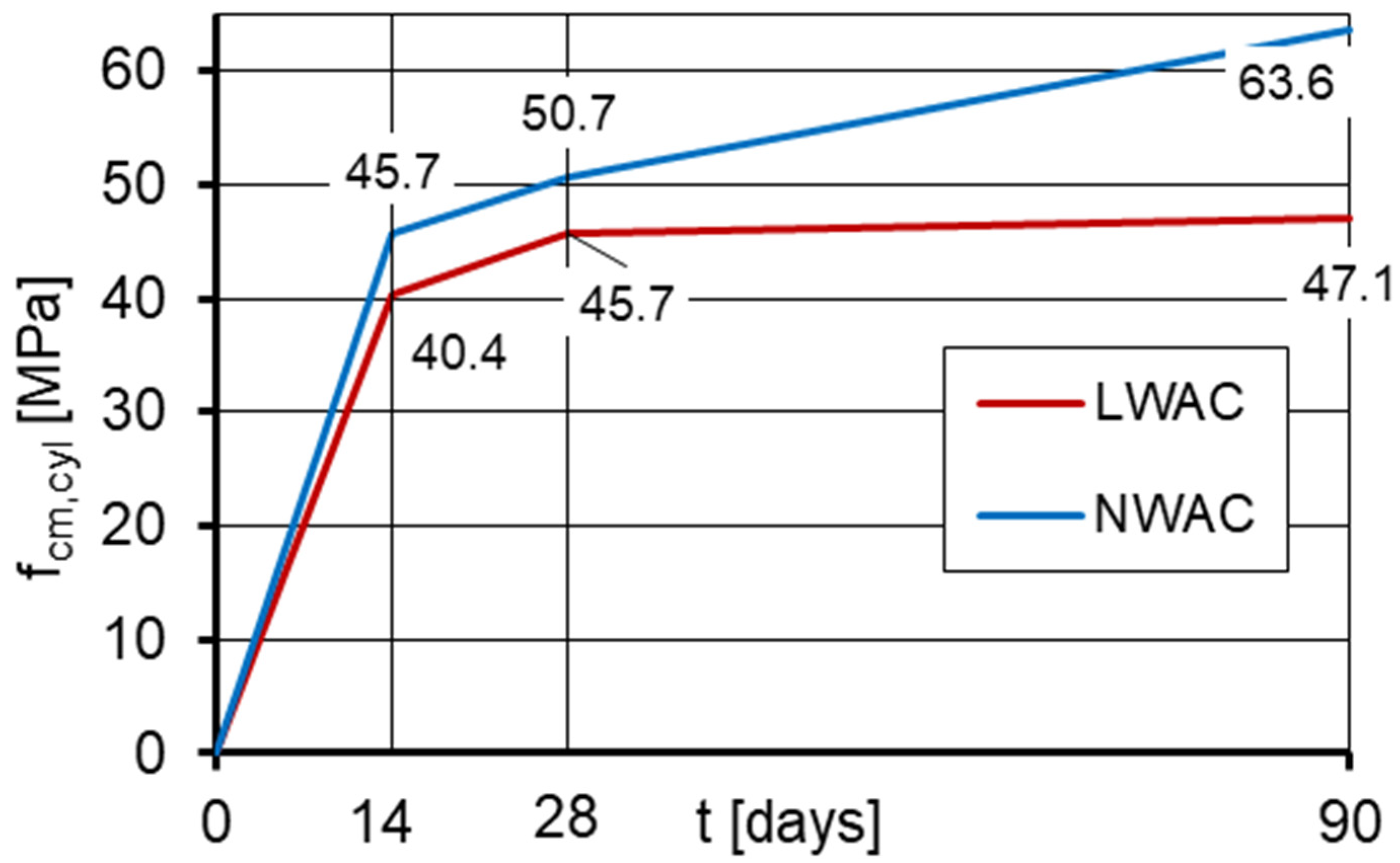

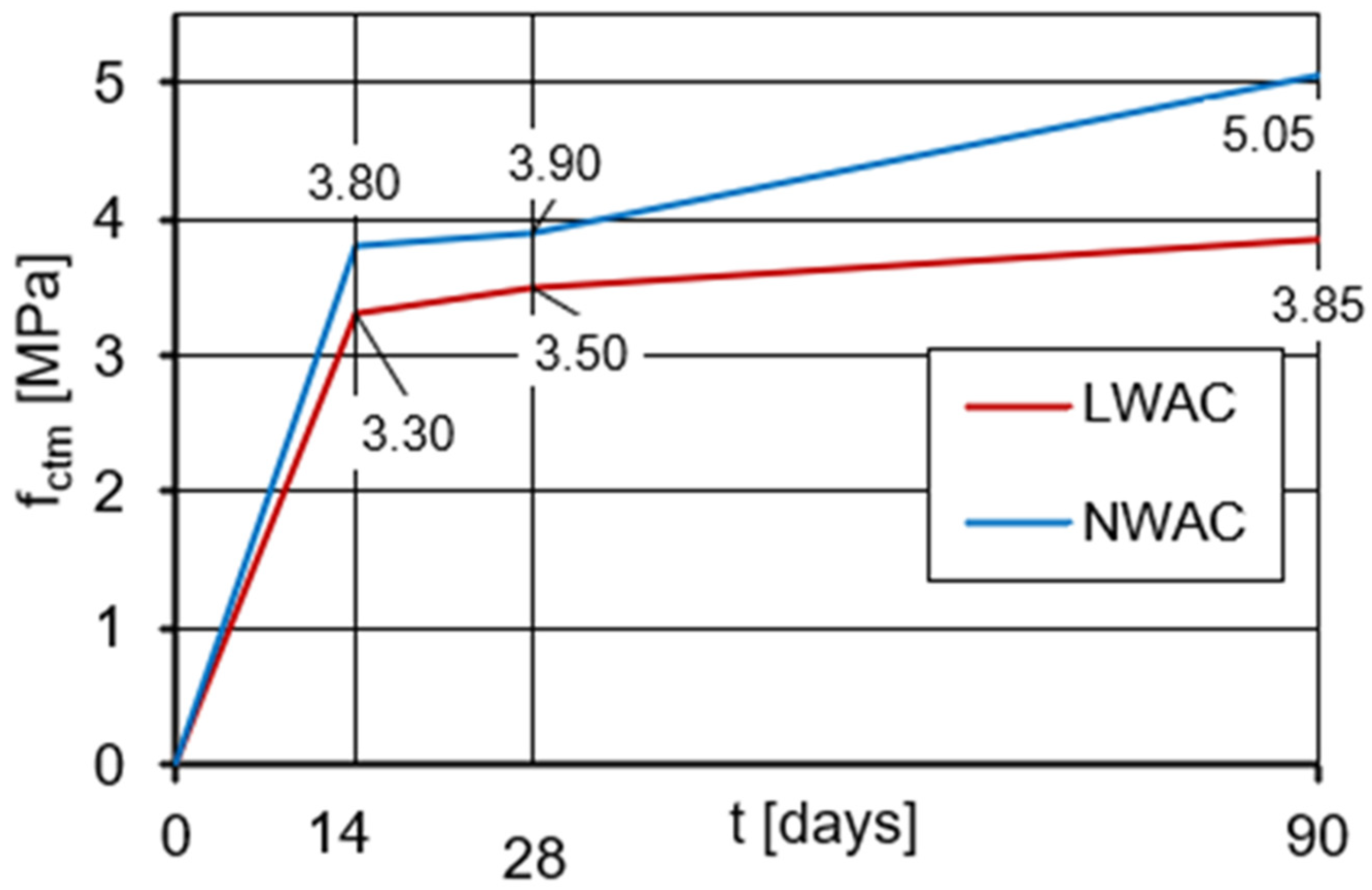
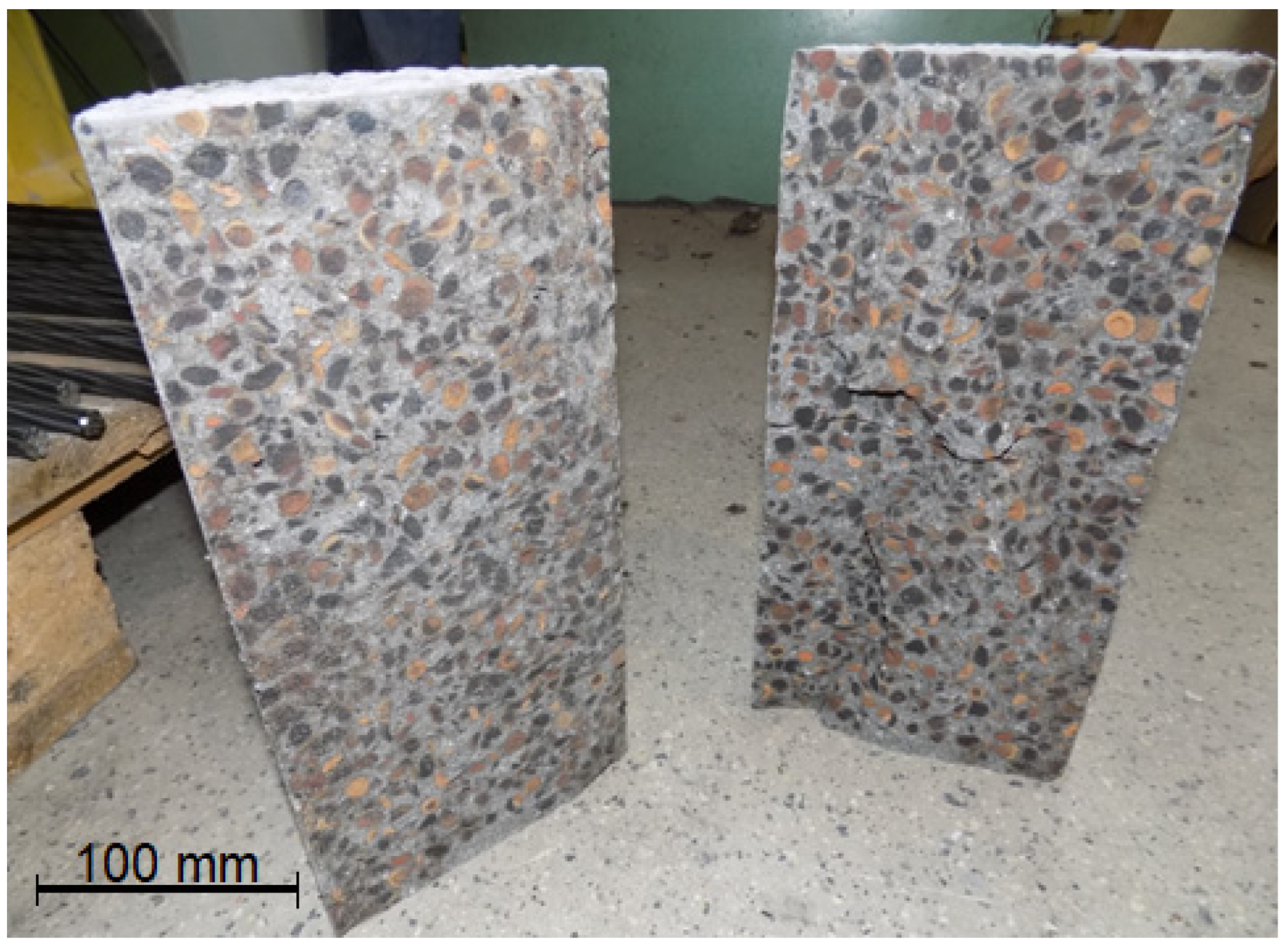

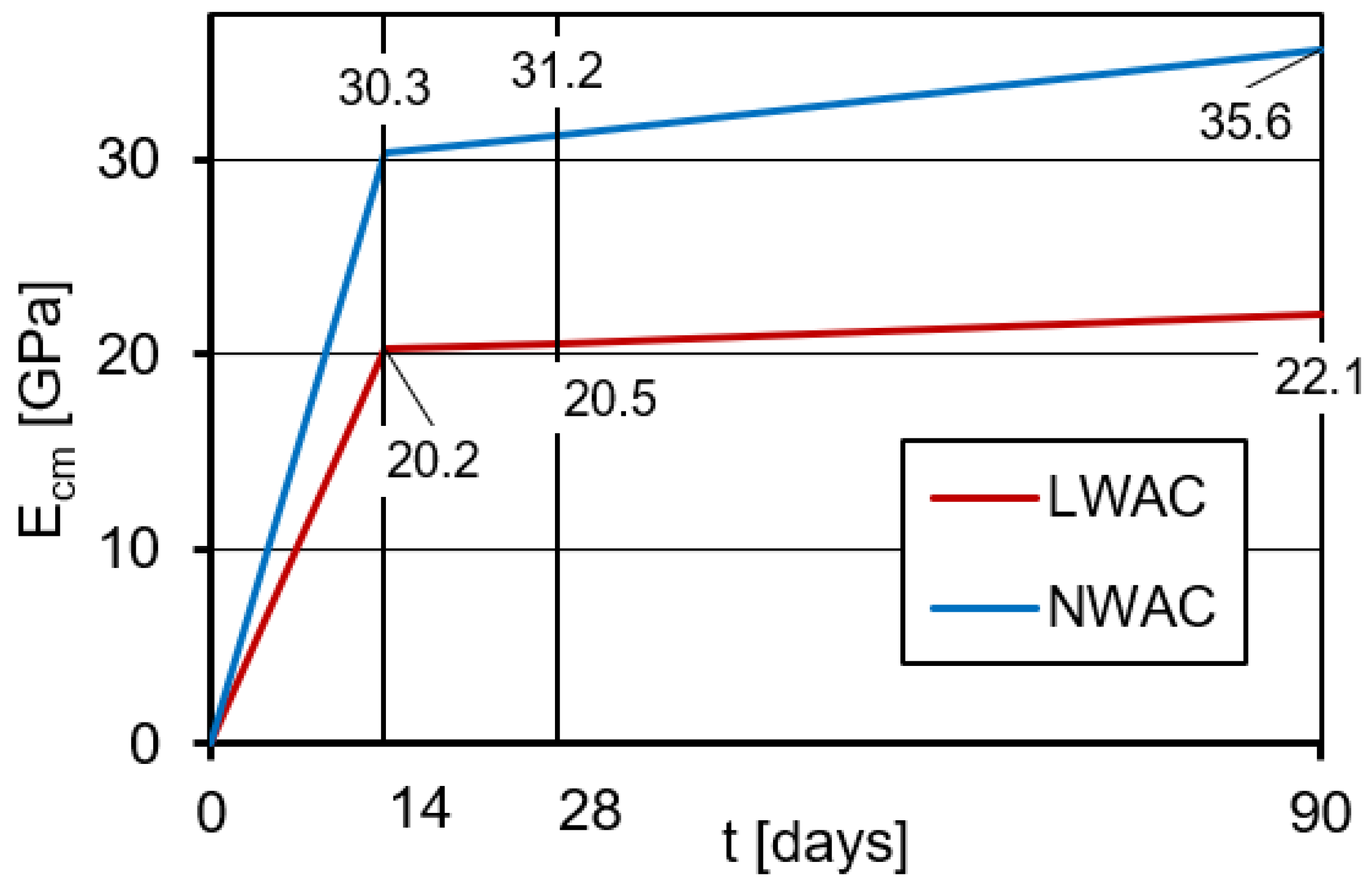
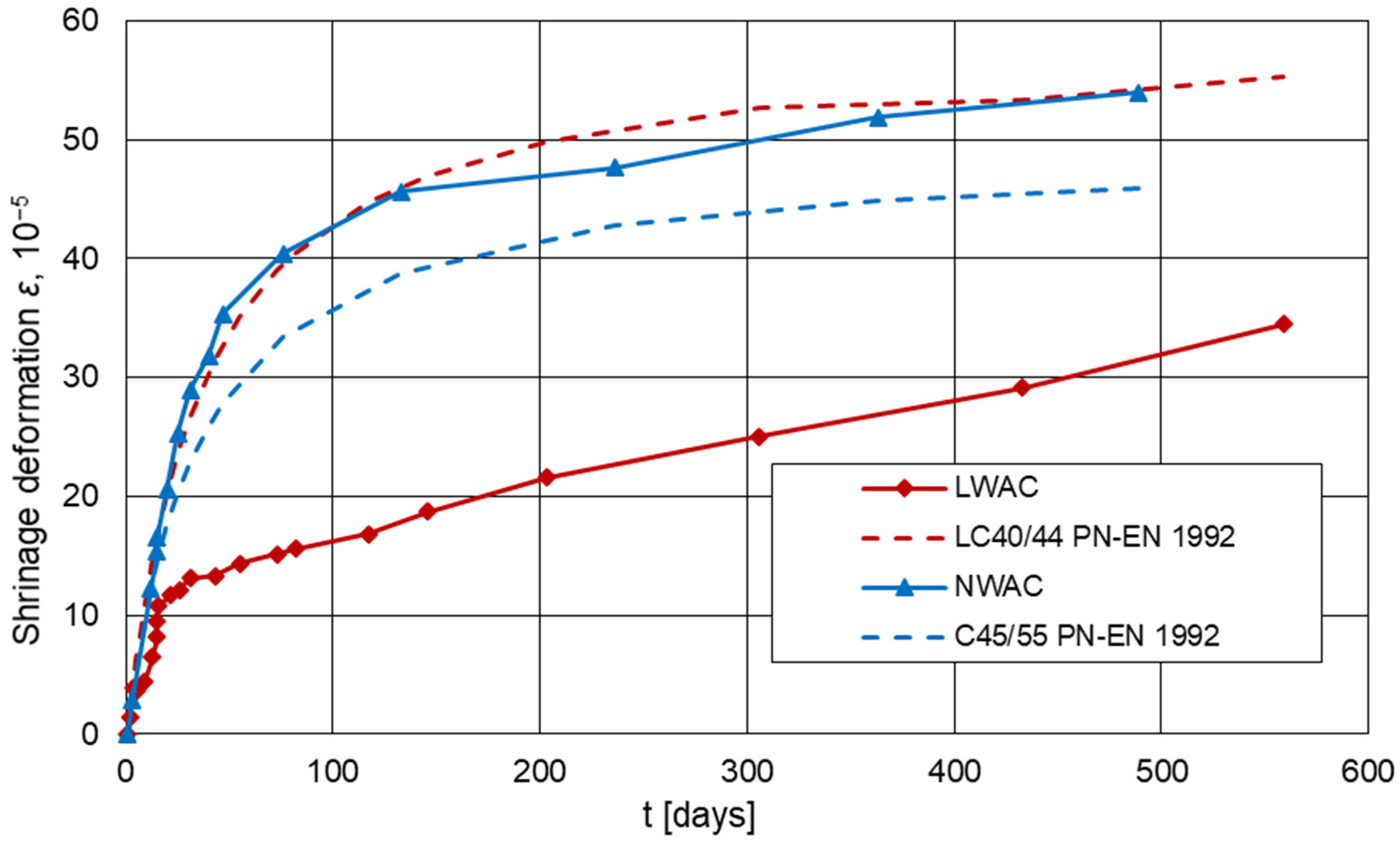

| Property | Certyd 4/16 mm | Dolomite 4/16 mm |
|---|---|---|
| Undersize particle content, % | 3.7 | 4.1 |
| Oversize particle content, % | 1.5 | 4.8 |
| Bulk density, kg/m3 | 730 | 1590 |
| Particle density, kg/m3 | 1380 | 2640 |
| Water absorption, (WA24h), % | 19.2 | 1.4 |
| Maximum water absorption, % | 21.8 | 1.6 |
| Crushing resistance, MPa | 7.8 | - |
| Constituent Materials | LWAC | NWAC |
|---|---|---|
| kg/m3 | kg/m3 | |
| Aggregate Certyd [4–16 mm] | 671 | - |
| Aggregate Dolomite [4–16 mm] | - | 1164 |
| Natural sand [0–2 mm] | 611 | 610 |
| Cement CEM I 42.5 R | 408 | 370 |
| Mixing water | 145 | 167 |
| Water for wetting Certyd aggregate | 128 | - |
| Superplasticizer SicaViscoCrete 6RS | 5.7 | 5.2 |
| Tests | European Standard Procedure | Specimen Type | Number of Specimens |
|---|---|---|---|
| Density | EN 12390-7 [33] | cylinder ϕ150 × 300 mm | 12 |
| Compressive strength | EN 12390-3 [34] | cube 150 × 150 mm | 18 |
| Compressive strength | EN 12390-3 [34] | cylinder ϕ150 × 300 mm | 18 |
| Modulus of elasticity | Method B, EN 12390-13 [35] | cylinder ϕ150 × 300 mm | |
| Tensile splitting strength | EN 12390-6 [36] | cylinder ϕ150 × 300 mm | 18 |
| Shrinkage | - | beam 200 × 200 × 1000 mm | 6 |
| Creep |
| Mean Density | LWAC [kg/m3] | NWAC [kg/m3] |
|---|---|---|
| In saturated condition | 1980 | 2320 |
| In natural condition | 1890 | 2270 |
| In oven-dry condition | 1740 | 2170 |
Disclaimer/Publisher’s Note: The statements, opinions and data contained in all publications are solely those of the individual author(s) and contributor(s) and not of MDPI and/or the editor(s). MDPI and/or the editor(s) disclaim responsibility for any injury to people or property resulting from any ideas, methods, instructions or products referred to in the content. |
© 2023 by the authors. Licensee MDPI, Basel, Switzerland. This article is an open access article distributed under the terms and conditions of the Creative Commons Attribution (CC BY) license (https://creativecommons.org/licenses/by/4.0/).
Share and Cite
Rodacka, M.; Domagała, L.; Szydłowski, R. Assessment of Properties of Structural Lightweight Concrete with Sintered Fly Ash Aggregate in Terms of Its Suitability for Use in Prestressed Members. Materials 2023, 16, 5429. https://doi.org/10.3390/ma16155429
Rodacka M, Domagała L, Szydłowski R. Assessment of Properties of Structural Lightweight Concrete with Sintered Fly Ash Aggregate in Terms of Its Suitability for Use in Prestressed Members. Materials. 2023; 16(15):5429. https://doi.org/10.3390/ma16155429
Chicago/Turabian StyleRodacka, Małgorzata, Lucyna Domagała, and Rafał Szydłowski. 2023. "Assessment of Properties of Structural Lightweight Concrete with Sintered Fly Ash Aggregate in Terms of Its Suitability for Use in Prestressed Members" Materials 16, no. 15: 5429. https://doi.org/10.3390/ma16155429
APA StyleRodacka, M., Domagała, L., & Szydłowski, R. (2023). Assessment of Properties of Structural Lightweight Concrete with Sintered Fly Ash Aggregate in Terms of Its Suitability for Use in Prestressed Members. Materials, 16(15), 5429. https://doi.org/10.3390/ma16155429






